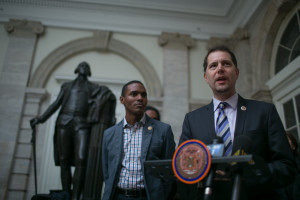
Council Member Mark Levine speaking with Council Member Ritchie Torres to his left. Image credit: William Alatriste/New York City Council
The watchlist and online map would keep track of affordable housing rental units at-risk of becoming unaffordable, as defined by specified criteria. On April 7, 2016, New York City Council Members Ritchie Torres and Mark Levine introduced a bill to implement the creation of a watchlist for affordable residential rental units Citywide that are at risk of losing their affordable-housing status. The bill provides the requisite criteria to be met by a residential rental unit listed on the watchlist, and calls on three separate City agencies to work together in creating and maintaining the watch list.
The bill, Intro 1153, would mandate the Department of Housing Preservation and Development to implement the “endangered affordable housing watchlist,” which would then be made publicly available on HPD’s website. The bill would also require the Department of Finance to work alongside HPD in making financial determinations about multiple dwellings potentially covered by the criteria. Further, Intro 1153 would require the Department of Information Technology and Telecommunications to create and post onto the City’s website an online map of the locations of the residential units on the watch list.
The criteria that is specified in the bill for locating these soon-to-be unaffordable housing units considers a dynamic array of the building characteristics. The criteria looks to the obvious signs that an apartment may lose its affordability status, such as whether the building will soon lose within a year its subsidies or its mandate to comply with affordability requirements under the affordable housing programs—like Section 8 and Mitchell-Lama apartments. However, it also looks outside-the-box at things such as whether the building is subject to currently pending foreclosure proceedings, whether the landlord is engaged in court proceedings for allegedly harassing tenants, and whether the building is the subject of open hazardous and immediately hazardous violations.
Council Member Ritchie Torres, lead sponsor of Intro 1153, envisions the bill as creating a tool that will bring awareness to tenants of the apartments on the watch list of their respective buildings’ at-risk status. “This bill would create a map of all the housing units in danger of becoming unaffordable across the city, and help us understand what is going on in our neighborhoods,” said Council Member Torres.
Council Member Mark Levine, Co-Chair of the City Council Affordable Housing Preservation Task Force, frames the issue solved by Intro 1153 as being the City’s lack of a comprehensive data set that would enable the City to pro-actively prevent affordable housing from losing its affordability status. “For decades, New York City has been rapidly losing affordable housing units. But today, there is no comprehensive data on the status of all affordable housing units in the city,” said Council Member Levine.
City Council: Intro 1153-2016 (April 7, 2016).
By: Jessica Soultanian-Braunstein (Jessica is the CityLaw Fellow and a New York Law School graduate, Class of 2015)

